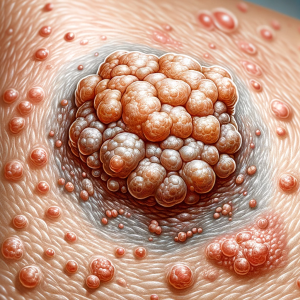 Abstract: This article provides an in-depth review of the early detection of squamous cell carcinoma (SCC) of the skin, focusing on risk factors, clinical features, diagnostic methodologies, and the importance of early intervention. It aims to guide clinicians in the timely identification and management of this common skin cancer.
Abstract: This article provides an in-depth review of the early detection of squamous cell carcinoma (SCC) of the skin, focusing on risk factors, clinical features, diagnostic methodologies, and the importance of early intervention. It aims to guide clinicians in the timely identification and management of this common skin cancer.
1. Introduction: Squamous cell carcinoma is the second most common form of skin cancer, arising from the keratinocytes of the epidermis. Early detection is crucial to reduce morbidity and improve patient outcomes.
2. Risk Factors: Key risk factors for SCC include prolonged exposure to ultraviolet (UV) radiation, immunosuppression, chronic skin inflammation, exposure to carcinogens (like arsenic), and genetic predisposition. Fair-skinned individuals are at a higher risk.
3. Pathophysiology: SCC typically arises in areas of the skin frequently exposed to UV radiation. UV-induced DNA damage leads to mutations in keratinocytes, disrupting normal cell regulation and causing malignant transformation.
4. Clinical Presentation: Early-stage SCC often presents as a scaly, erythematous plaque or nodule on sun-exposed skin. Lesions may be tender or bleed easily. Precursor lesions, such as actinic keratoses, are indicative of increased SCC risk.
5. Diagnostic Approaches: Early diagnosis relies on thorough skin examination and patient history. Suspicious lesions warrant a biopsy, typically an excisional or punch biopsy, for histopathological examination.
5.1 Dermoscopic Evaluation: Dermoscopy can aid in the differentiation of SCC from other skin lesions. Characteristic features include keratin scales, blood vessels in a radial arrangement, and a white halo surrounding the lesion.
6. Importance of Early Detection: Early detection of SCC is associated with a high cure rate and minimal morbidity. Delayed diagnosis can lead to local invasion, metastasis, and increased complexity of treatment.
7. Prevention and Screening: Preventive measures include sun protection, regular skin examinations, and patient education regarding skin cancer signs. High-risk individuals may benefit from more frequent dermatological evaluations.
8. Conclusion: Early detection of squamous cell carcinoma of the skin is imperative for successful management. Clinicians must be vigilant in assessing patients with risk factors or suspicious skin lesions to ensure timely diagnosis and intervention.








